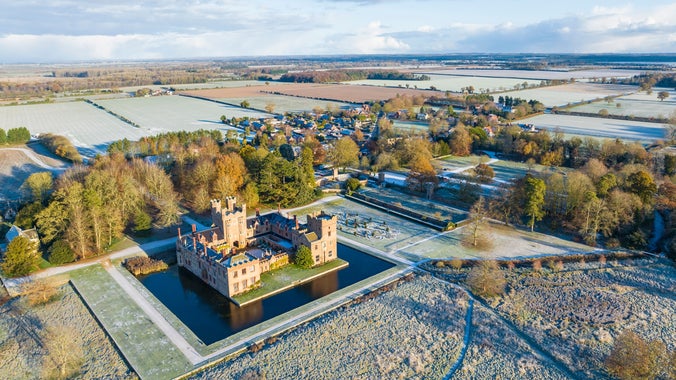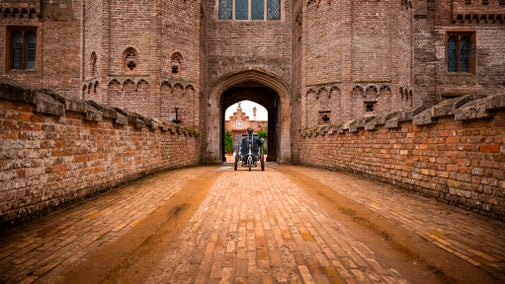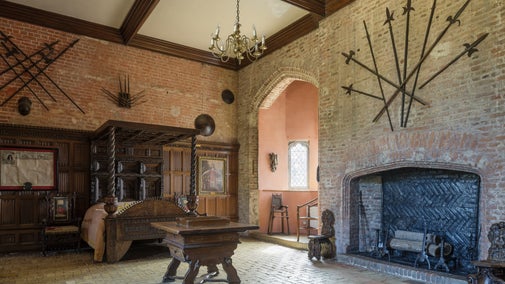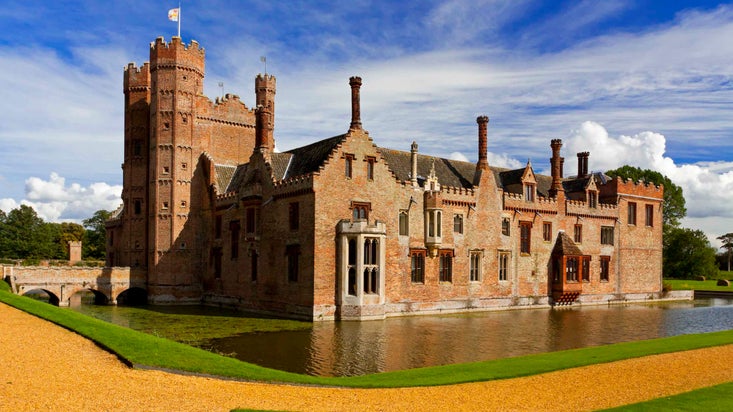
Become a member
Join today and help protect nature, beauty and history – for everyone, for ever. Enjoy access to more than 500 places with National Trust membership.
Home to the Bedingfeld family for 500 years, Oxburgh reveals one family's unshakable Catholic faith and story of endurance
Oxborough, near Swaffham, Norfolk, PE33 9PS

| Asset | Opening time |
|---|---|
| Hall (last entry at 2.15pm) | 10:30 - 15:00 |
| Garden | 09:30 - 16:00 |
| Parkland | 09:30 - 16:00 |
| Servants’ Hall tea-room | 10:00 - 15:00 |
| Shop | 10:00 - 15:00 |
| Second-hand book shop | 09:30 - 15:30 |
| Car Park | 09:30 - 16:00 |
| Ticket type | With Gift Aid | Without Gift Aid |
|---|---|---|
| Adult (18+) | £14.30 | £13.00 |
| Child (5-17) under 5s free | £7.20 | £6.50 |
| Family (2 Adults and up to 3 children) | £35.80 | £32.50 |
| Group (Adult 18+) | £12.35 | |
| Group (Child 5-17) | £6.18 |
Our second-hand bookshop boasts a great selection of pre-loved books.
Free parking on site.
A bicycle rack is available in the visitor car park; however, the paths throughout the estate are not suitable for bicycles.
We love dogs at Oxburgh, but only assistance dogs are permitted inside Oxburgh Hall.
Explore a wide selection of garden essentials, food and drink, and beautiful homeware.
Whether you’re refuelling after a walk or catching up with friends over a light lunch, you’ll find plenty of tasty treats during your visit.
Blue Badge parking and drop-off point. Accessible toilets. Some gravel pathways and two steep slopes in garden. Manual wheelchairs and Mountain Trike all-terrain wheelchair available to borrow from the Welcome Team on arrival.
The hall is located 250 meters from the main car park, accessible via a flat, loose gravel path.
A braille guide is available for Oxburgh Hall.
Nine accessible parking bays are available, 20 meters from Visitor Welcome.
A drop-off point is available, 20 meters from Visitor Welcome.
A hearing induction loop is available at every till point.
A large print guide is available for Oxburgh Hall.
The main pathways in the Formal Gardens are flat with loose gravel.
The ground floor of the hall is wheelchair accessible although some doorways are narrow and may not be suitable for PMVs. A wheelchair is available on request.
A PMV is available for hire free of charge. To reserve it, please email oxburghestate@nationaltrust.org.uk at least 3 days in advance of your visit. Please note that due to team capacity, the PMV is unavailable on bank holiday weekends.
Seating is regularly available inside Oxburgh Hall and within the Formal Gardens.
A number of wheelchairs and an all-terrain trike are available to hire for free. Please speak to a member of the team on arrival.
Find out what's happening at Oxburgh throughout the festive season...

Across the gardens, wider estate and within the hall, we have been working hard to improve access and make Oxburgh a welcoming place for everyone who visits.

Whether you're building a den, becoming a nature explorer or searching for secret doorways, Oxburgh has plenty to keep the whole family entertained.

Enjoy something to eat and drink in the Servants' Hall tea-room or the Pantry café during your visit. You'll also find our Courtyard Giftshop and the Potting Shed second-hand bookshop.

Oxburgh Estate is a two pawprint rated place. To help everyone have a fantastic time when you visit with your dog, we ask that you follow this guidance.


Are you looking to organise a special day out for a group? From exploring our iconic moated manor house to wandering through the beautiful gardens, there's something for everyone at Oxburgh Estate.

Moated medieval manor house with Victorian Gothic interiors, home to the Bedingfield family for over 500 years who still live here in private apartments.
A Victorian garden, including a kitchen garden and orchard, the French-inspired Parterre, a wilderness area and My Lady's Wood.
Nestled on the edge of the Norfolk Brecks, with historic parkland, woodland, wildflower meadows and rare chalk river.
Enjoy something to eat and drink in the Servants’ Hall tea-room or the Pantry café during your visit.
Whether you're treating yourself or looking for that perfect present, you'll find garden essentials, food and drink, and beautiful homeware in our shop.
Boasts a great selection of pre-loved books for you to browse and find your next book you can’t wait to curl up with.
We have a beautiful selection of plants for your garden, some of which are grown right here on the estate.
Silent Space is a not-for-profit initiative that creates opportunities for silent reflection in numerous green spaces in the UK. Oxburgh’s Silent Space is tucked away at the far end of the Wilderness walk.

Wander around the Kitchen Garden and discover what’s growing this season as well as what's in bloom in the newly restored Peach House Border. Enjoy the tranquillity of The Orchard and the Herbaceous Border overlooking the Hall or venture further afield to explore the less formal areas of The Wilderness and My Lady’s Wood.

Oxburgh has been home to the Bedingfelds for more than 500 years, and they still live within private apartments at Oxburgh today. Discover what you might see on your visit.

Oxburgh Estate is nestled on the edge of the Norfolk Brecks, where the land meets the wide-open Fenlands. Discover the wider parkland, and the wildlife that makes their home here.

Join us along with Father Christmas and our winter woodland friends as we celebrate the festive season at Oxburgh Estate

Come and spy the first glimpse of spring as the snowdrops start to peep through the soil and provide a taste of what the change in season will bring over the coming weeks and months.

Join us for some family fun at Oxburgh Estate!

Take a look at the events that we have at Oxburgh, from guided garden tours, immersive indoor tours, family fun and conservation in action. There is so much to explore...

Enjoy something to eat and drink in the Servants' Hall tea-room or the Pantry café during your visit. You'll also find our Courtyard Giftshop and the Potting Shed second-hand bookshop.


Stay in a traditional 19th-century Norfolk cottage, nestled in the grounds of Oxburgh Estate.
Enjoy a walk through the Norfolk countryside, taking in some of the protected farmland and heritage that surrounds the National Trust-managed Oxburgh Hall.

Embrace the spirit of Christmas with a range of festive crafts and create beautiful decorations to take home and treasure.
Step into the magic of Christmas at Oxburgh Hall this December.
The gardeners of Oxburgh lead you on a tour of other areas of the Snowdrop displays.
It’s hard not to fall in love with Oxburgh Estate, when you catch your first glimpse of the imposing brick manor house reflected in the tranquil moat.
Built by the Bedingfeld family in 1482 as a statement of power, Oxburgh and the family have endured turbulent times. Through religious persecution, Civil War devastation, near dereliction and threatened demolition, Oxburgh’s story is one of survival.
Step inside to discover the legacy of the 6th Baronet who created much of what you see today, from the Victorian Gothic interiors to the ornate architectural additions that reflect a romantic view of Oxburgh's medieval past.
Outside, the gardens are a mixture of formal and wilderness, with the kitchen garden, orchard and herbaceous border adding colour and seasonal interest. And for those wanting to explore further, you can follow one of the estate walks through woodland, along the River Gadder, and out into open meadows.
Oxburgh Estate was built as a family home, and the Bedingfelds have now lived here since 1482, surviving Civil War, periods of near dereliction, and the threat of demolition.

From early Tudor portraits and rare manuscripts to colourful 19th-century wallpapers, Oxburgh's contents reveal the collecting habits of the Bedingfeld family.

Following analysis by National Trust experts, a work of art seen by thousands of people every year here at Oxburgh has been found to be an exceptionally rare survival of a work by the inventor of colour printing, Jacob Christoff Le Blon

Find out about the work we do to conserve Oxburgh Estate now and for generations to come, from growing fresh produce and planting trees, to protecting the collection from pests.

Contractors have overcome the challenge of repairing a wall inside a moat, after water levels dropped and a sinkhole appeared. The water in the moat plays a vital role in stabilising the foundations of Oxburgh Hall, a 15th century landmark in Norfolk. Visitors can experience conservation in action as the moat project continues through to the end of June.

2000 wildflowers have been planted along the banks of one of England’s rare chalk rivers, on the National Trust’s Oxburgh Estate. The new vegetation cover will also support Britain’s fastest declining mammal, the water vole which have recently returned to Oxburgh after years of absence.

Work is set to resume in early 2026 to retore the historic Parterre Garden at Oxburgh Estate. The work will help combat the effects of climate change on the historic planting choices and make the Parterre more compatible with a 21st Century climate.

Dedicated to improving accessibility for everyone, the National Trust and Oxburgh Estate in Norfolk are introducing a new children’s all-terrain Mountain Trike wheelchair to their existing range of mobility equipment.

Discover how we're restoring the parkland at Oxburgh Estate to become a species rich, native wood pasture once more, which will attract wildlife and increase biodiversity.
Find out more about the £6 million project at Oxburgh Estate, which included repairs to the roof, windows, chimneys and medieval gatehouse façade, securing Oxburgh’s future and the collection within.
Do you have some spare time to help us look after Oxburgh Estate? Discover the volunteering roles available, from gardening to tour guiding, and how to apply to join the team.


Join today and help protect nature, beauty and history – for everyone, for ever. Enjoy access to more than 500 places with National Trust membership.
By sharing your email address you’re agreeing to receive marketing emails from the National Trust and confirm you’re 18 years old or over. Please see our for more information on how we look after your personal data.